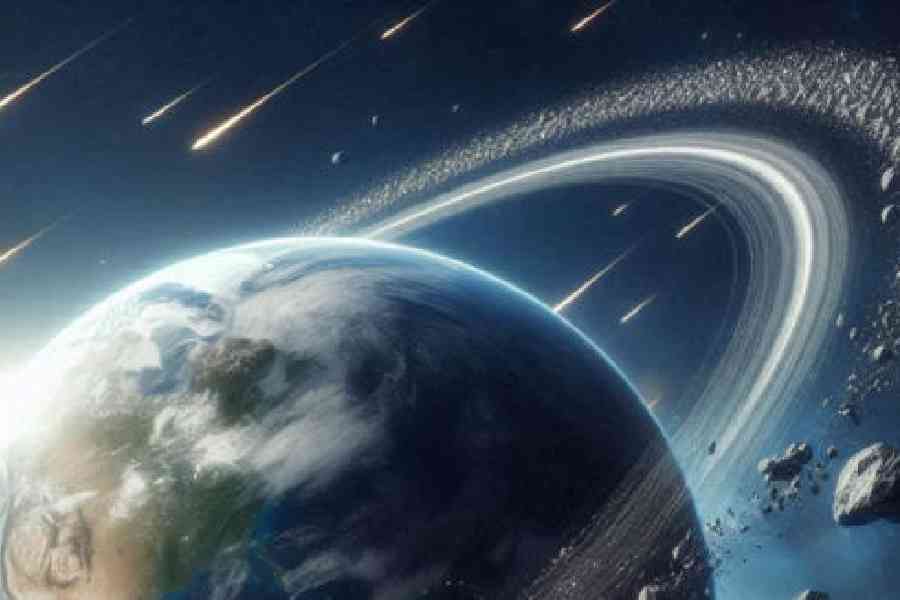If you were to look up from Earth some 466 million years ago, you might have seen a gleaming ring stretching across the sky, some scientists say.
A study published this month links an uptick in impact craters during the Ordovician Period, an era before animals lived on land, to a ring made of asteroid debris that encircled our planet for millions of years.
Scientists have long speculated about the origin of the Ordovician meteor event, when Earth was bombarded by space rocks at an unusually high rate, producing dozens of craters and sediments packed with meteorites. Previous research implicated a large asteroid that broke apart in the main belt between Mars and Jupiter and sent rocky shrapnel into the inner solar system, where it pelted our planet.
But what if this ancient object burst into pieces at our doorstep? Researchers led by Andy Tomkins, professor of Earth and planetary sciences at Monash University in Australia, envision an asteroid that passed within thousands of kilometres of Earth, close enough to be ripped apart by the planet’s gravity. The debris from the breakup then coalesced in a ring around the equator, a scenario that may be linked to dramatic changes in climate and biodiversity at the time.
“I got the idea when I read a popular science article about Phobos and Deimos, the moons around Mars, having formed from leftover bits of a ring around Mars,” said Tomkins, whose study was published in Earth and Planetary Science Letters. “That made me think how would I see, in the geological record, if Earth had had a ring in the past as well.”
Tomkins and his team mapped out where on Earth 21 craters from the Ordovician would have been located at that time. If the debris had come from the asteroid belt, the craters should have been distributed all over the planet. But the craters were clustered around the equator, hinting that they were made by meteorites falling from an equatorial ring.
“That’s what gave it away,” Tomkins said. “They’re all fairly close to the equator, and it’s pretty hard to do that by normal impact cratering processes.”
The team argues that there is, as yet, no evidence Mars and the moon experienced similar spikes in impact cratering at this time, suggesting that the debris was localised to Earth. In addition, the researchers pointed to Ordovician meteorites from Sweden that show low exposure to the radiation of space, meaning that the rocks fell to Earth within tens of thousands of years after the disintegration of their parent body. Debris from the asteroid belt, in contrast, is typically exposed to space radiation for millions of years.
The team also pondered whether shade cast onto Earth by the ring cooled the planet, triggering a major glaciation called the Hirnantian ice age that shook up the trajectory of life. Tomkins said that this connection was more speculative, but merited further study.
These “multiple bits of evidence” combine into what “we think is a plausible hypothesis”, Tomkins said.
Birger Schmitz, a professor of geology at Lund University in Sweden, praised the team’s novel and creative approach but said that more data is needed.
“The paper takes a completely new perspective, and this will definitely bring us a step forward toward an understanding of what happened in the Ordovician,” said Schmitz, who is also affiliated with the Purple Mountain Observatory in China.
Gretchen Benedix, a professor of Earth and planetary sciences at Curtin University in Australia, called the study “tantalising” but remained unconvinced. She noted that meteorites might have been impacting far from the equator without leaving surviving geological traces. She was also skeptical of the proposed link between the ring and the Hirnantian ice age. “There are a lot of hypotheticals here, and that’s not a bad thing,” Benedix said of the study. “But I think there is physics and chemistry that has to be worked out.”
To that end, Tomkins and colleagues outlined methods to test their hypothesis, including studies of Ordovician meteorites at different latitudes and more complex models of how a disintegrating asteroid might form an Earth ring.
“What I like in particular is that the authors present a testable idea,” Schmitz said. “By searching for meteoritic minerals in sediments from different latitudes, we will get an answer as to whether Earth indeed had a ring.”
For now, it’s captivating to imagine a bygone Earth, inhabited almost entirely by marine life, ringed by the remnants of a broken space rock.
New York Times News Service










